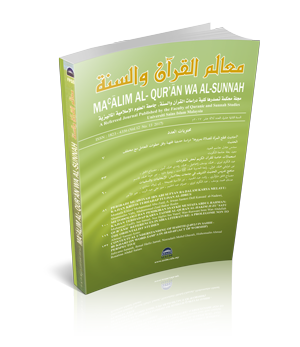ظاهرة التناص مع القرآن والحديث في رواية "القاهرة الجديدة" لنجيب محفوظ: دراسة وصفية تحليلية
The Phenomenon of Intertextuality with the Quran And Hadith in the Novel “Cairo Modern” by Naguib Mahfouz: A Descriptive and Analytical Study
DOI:
https://doi.org/10.33102/jmqs.v20i1.470الكلمات المفتاحية:
Intertextuality، Religious Intertextuality، Holy Quran، Noble Prophetic Hadith، Naguib Mahfouz، Cairo Modernالملخص
The concept of religious intertextuality involves integrating selected religious texts, whether from the Holy Quran or the noble Prophetic Hadith, into the original text of a novel. These texts are carefully chosen to harmonise with the narrative context and serve a cognitive or artistic purpose. It is undeniable that the Holy Quran and the Prophetic Hadith are among the most significant sources from which both ancient and contemporary novelists have drawn inspiration, prominently featuring them in their creative works. Consequently, this research aims to investigate the phenomenon of religious intertextuality in Naguib Mahfouz’s novel “Cairo Modern,” intending to comprehend the reason for its employment within the novel’s texts. The research follows a descriptive-analytical statistical methodology. Among the key findings are that Naguib Mahfouz was significantly influenced by Islamic culture, as evidenced by his extensive incorporation of religious texts from the Holy Quran and the Prophetic Hadith in “Cairo Modern.” This influence extends to shaping the events and narrative structure, enriching the fictional texts to generate new meanings. The results also suggest that creative writing critically depends on such literary vitality derived from the mechanism of interweaving and blending known texts, known as intertextuality. This process proves to be a crucial and dynamic tool for both authors and readers alike.
المراجع
Ahmed Bhuiya, Md. Hussain, “Analytical Study of Naguib Mahfouz Novel al Qahira al Jadida”, International Journal of Humanities & Social Science Studies, 1(4), 2015.
Abu ‘Abdullah Aḥmad Ibn Muḥammad Ibn Ḥanbal Ibn Hilāl ibn Asad al Shaybānī. Musnad al Imām Aḥmad bin Ḥanbal.1st ed. N.P: Muassasah al Risālah, 2001.
Abu Ya’qūb Ishāq Ibn Ibrāhīm bin mukhallad Ibn Ibrāhīm al Ḥanẓalī al Marūziī. Musnad Isḥāq Ibn Rahwayh. al madinah al Munawwarah: Maktabah al Īman, 1991.
al bādī, Ḥiṣṣa. al Ṭanāṣ fī al Sy’ir al ‘Arabī al Ḥadīth. Oman: Dār Kunūz al Ma’rifah, 2008.
Aḥmad, Amal Aḥmad ‘Abdul Laṭīf. “Al Ṭanās fi Riwāyat Ilyas khūrī”. Master's Thesis, An-Najah National University, 2005.
‘Abd al Rāḍī, Aḥmad Muḥammad. Naḥw al Naṣ baina al ‘Aṣālah wa al Ḥadāthah. 1st. ed. al Qāhirah: Maktabah al Thaqāfah al Dīniah, 2008.
ʻAbd al-Muṭṭalib, Muḥammad. Qaḍāyā al Ḥadāsath ‘inda ʻAbd al-Qāhir al-Jurjānī. Beirut: Maktabah Lubnān Nāshirūn, 1995.
‘Afīfī, Aḥmad. Naḥw al Naṣ Ittijāh Jadīd fī al Dars al Naḥwī. 1st ed. al Qāhirah: Maktabah Zahrā’ al Sharq, 2001.
Baqsha, ‘Abdul Qādir, al Ṭanāṣ fī al Khīṭāb al Naqdī wa al Balāghi: Dirāsah Naẓariah wa Taṭbiqiah. al Magrib: Afrīqia al Sharq, 2007.
Beaugrande, Robert de. al Naṣ wa al Khiṭāb wa al Ijrā’. Trans: Tammām Hassān. 1st. al Qāhirah: ’Ālam al Kutub, 1998.
Biwālṭīn, Ḥusainah. “Al Ṭanas fī al Riwāyah al Jazāiriah: Riwāyah Amīn al ‘Ilwānī li Faiṣal al Aḥmar Namuzajan". University of Jijel, 2015.
Buḥairī, Sa’īd Ḥasan. (2000). “Ittijāhāt Lughawiah Mu’āṣirah fī Taḥlīl al Naṣ”. Majallah ‘Alāmāt fī al Naqd. al Nādī al Adabī al Thaqāfī bi Jaddah, 10(38). 133-222.
Dāgir, Shirbul. “Al Ṭanāṣ Sabīlan ila Dirāsah al Naṣ al Syi’rī”. Majallah al Fuṣūl al Qāhirah, Januari 1997, 124-146.
Ḥassān, Tammām. Naḥw al Jumlah wa Naḥw al Naṣ. Text of a lecture given at the Arabic Language Institute in Umm Al-Qura Mecca during the summer cultural season of 1995.
Ibn Abī Usāmah, Abū Muḥammad al Ḥārith ibn Muḥammad ibn Dāhir al Tamīmī al Baghdādī al Khaṣīb al Ma’rūf. Bughyah al Bāhith ‘An Zawāid Musnad al Ḥārith. al Madīnah al Munawwarah: Markaz Khidmah al Sunnah wa al Sīrah al Nabawiah, 1992.
Kristeva, J. (1997). ’Ilm al Naṣ (2nd ed.). (‘Abd al Jalīl Nāẓīm, Trans.). 2nd ed. Morocco: Les Edition Toubkal. (Original work published 1969)
al Shāfi’ī, Abū ‘Abdullah Muḥammad bin Idrīs. al Musnad. Lubnan: Dār al Kutub al ‘Ilmiah.
Ṣuhaib 'Abdul Jabbār, al Jāmi' al-Ṣaḥih li Sunan wa al Masānīd. 2014.
Maḥfūz, Najīb. al Qāhirah al Jadīda. 4th ed. al Qāhirah: Dar al Syuruq, 2016.
Muḥammad, ‘Izzah Shibl. ‘Ilm Lughah al Naṣ: Al Naẓariah wa al Ṭatbiq. 1st ed. Maktabah al Adab, 2009.
Turābī, ‘Abdul Qāsim & Wasīdī, Sayyīd Ḥusain. 2014. “Riwāyāt Najīb Maḥfūz fī Ḍau’ al Naqd al Ijtimā’ī Ma’a ‘Ināyah Khaṣṣah bi Riwāyah Awlād Ḥāritnā”. Majallah ‘Iḍā’āt Naqdiah. 4(13). 125 – 146.
‘Umar, Aḥmad Mukhtār. Mu’jam al Lughah al ’Arabiah al Mu’āṣirah. 1st ed. al Qāhirah: ’Ālam al Kitāb, 2008.
Wattār, Muḥammad Riyād. Tawẓīf al Turath fī al Riwāyah al ‘Arabiah. Dimashq: Ittiḥād al Kitāb al ‘Arab, 2002.
al Zahrā’, Fāṭimah & Sa’īd, Muḥammad. Sambulisim dir athar najib mahfuz. Trans: Najmah Rajāī. n.p. Ferdowsi University of Mashhad, 1999.
al Zu’bī, Aḥmad. al Tanāṣ Naẓarian wa Taṭbiqian. Oman: Muassasah ‘Amūn li al Nashr, 2000.
Zawāriq ‘Āishah. “Al binyah al Zamkāniah fī Riwāyah al Qāhirah al Jadīdaj li Najīb Maḥfūz”. University Mohamed Boudiaf M'sila, 2015.
التنزيلات
منشور
كيفية الاقتباس
إصدار
القسم
الرخصة
الحقوق الفكرية (c) 2024 Mohd Azizul Rahman bin Zabidin, Ebrahim Mohammad Ahmad Eldesoky, Ummu-Hani Abas, Abdul Ghani bin Md Din

هذا العمل مرخص بموجب Creative Commons Attribution 4.0 International License.
The copyright of this article will be vested to author(s) and granted the journal right of first publication with the work simultaneously licensed under the Creative Commons Attribution 4.0 International (CC BY 4.0) license, unless otherwise stated.
Authors are able to enter into separate, additional contractual arrangements for the non-exclusive distribution of the journal's published version of the work (e.g., post it to an institutional repository or publish it in a book), with an acknowledgement of its initial publication in this journal.
Authors are permitted and encouraged to post their work online (e.g., in institutional repositories or on their website) prior to and during the submission process, as it can lead to productive exchanges, as well as earlier and greater citation of published work.









